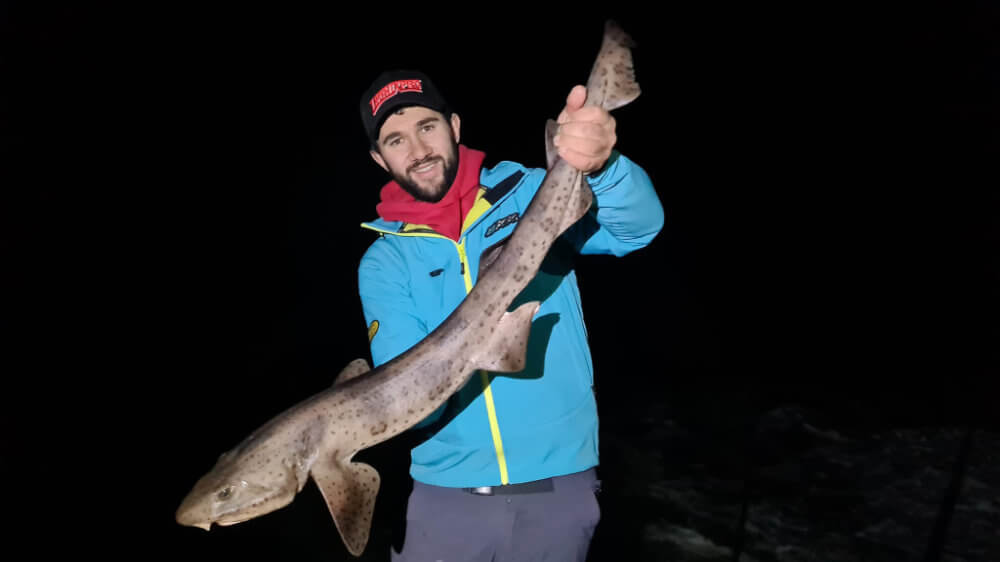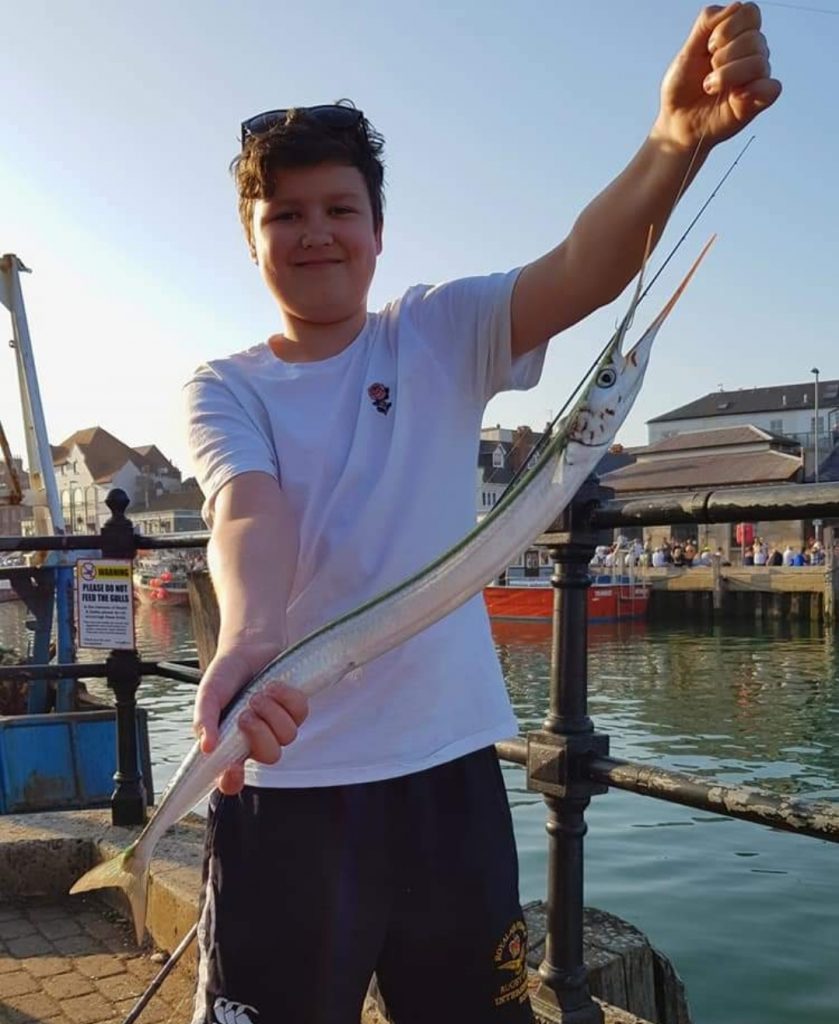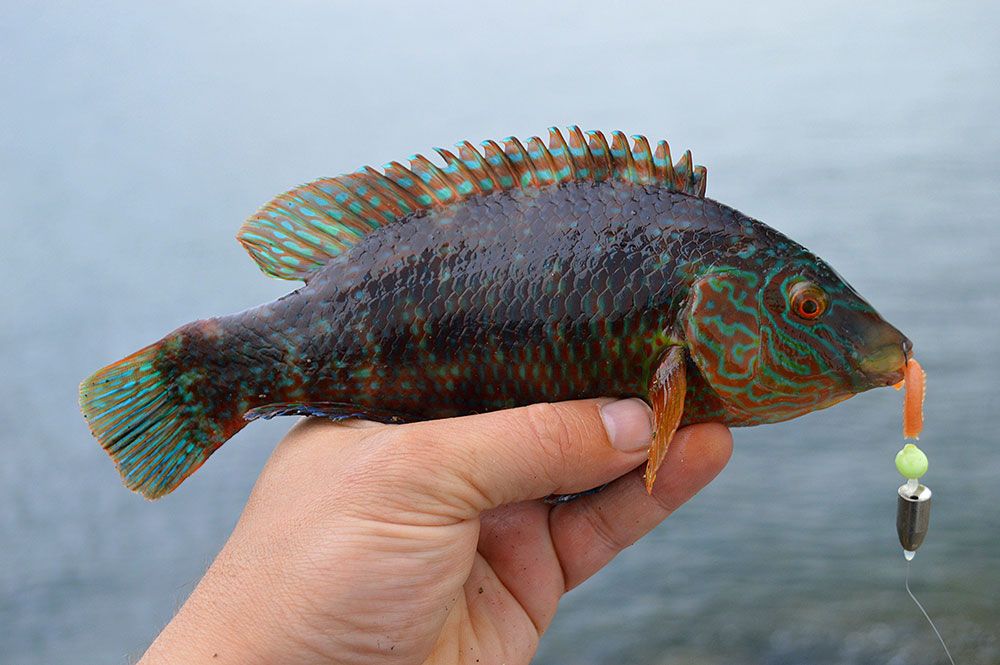Man-made breakwaters are fish magnets. They are typically made from large armour rock boulders that loosely fit together with a flat walkway on top. The loose fitting boulders create holes between the rocks that are havens for smaller species such as wrasse, pout and poor cod, which in turn bring in the bigger fish like conger, huss, bass, and cod.
The ends of breakwaters also deflect the tide flow and this too can attract bigger predators into the area, with other species drawn to the slacker water found inside the protected inner breakwater.
Season
Breakwaters will fish all year round. In winter time they give consistent fishing for whiting, dabs, herring, conger and maybe cod and huss. In summer, most species will be found around breakwaters including plaice, conger, huss, rays, bass, flatfish, gurnards, mullet, wrasse, garfish, mackerel, plus a host of lesser species.

Breakwater Structure and Tide Effect
Looking in more detail at the structure of a breakwater, the big boulders push out at an angle to form the base and are then piled up on themselves to form the wall-like structure.
On the seaward side where the swell continually hits the sea wall, you usually find that you’ll be fishing onto mainly rough ground as the swell will constantly rush up the breakwater side, then fall back scouring out the sand and sediment. This is a good spot for bass and cod, plus maybe the odd conger and huss if the rough ground is heavy enough.
The end of the breakwater will see a quickening of the tide as it pushes round the end. This is where bass hold up sitting below and to the side of the fast water looking to intercept fish like sandeels, garfish and mackerel as they get swept past. This is always a good spot for spinning and fishing feathers. Also take note where this push of tide starts to slow and ease well past the breakwater end. This tide flow will create sandbanks and gullies here as it eases that will hold flatfish and rays.

On the inside of the breakwater, the tidal effect is lessened with a back eddy effect of slacker water. This is the spot to target mullet and garfish on float tackle, with ledgered baits picking up a wide variety of species including whiting, dabs, flounder, dogfish, pout, poor cod and others.
The majority of fish will be tight to the junction line where the base of the boulders meet sand or mud. Food collects along this line and draws in the smaller species. The conger waits in the holes to pounce as prey fish pass, so dropping bigger baits tight into the rock edge is the tactic for these, and the huss, with bonus big bass possible. Smaller baits will take most of the wrasse species and again these are in the holes in the rocks so keep casts tight in.
On the inside of the breakwater, also look for the channels that boats use to gain access to the harbour or moorings. These are usually kept deeper by boat traffic and harbour maintenance and will be marked by buoys etc. These are good spots for rays in deeper water, but even in water of just a few feet, they will hold flatfish. And, as the tide starts to flood through these, fish like bass, cod, and whiting use them as routes to richer feeding.
The chains that hold mooring buoys in place are always covered in seed mussel and both flounder and plaice will bury into the sand and mud around these and feed on them, but mostly use the chains as a partial hiding place. These are always good spots to place baits on a flooding tide.
Weather and Tides
When it comes to weather, think safety. Calm to moderate conditions with light winds off the sea can fish well fishing the seaward side of the breakwater, even in bright conditions, though overcast skies or nighttime are best. You’ll often find that it’s the smaller to medium-sized tides that maintain an overall depth that fish best here. Spring tides when the water goes very shallow can limit fishing to two hours either side of high water.
The end of the breakwater where the tide races past is a spot for early morning and late evening fishing in calm weather conditions. A light overcast sky is good here as the bass can see the silhouettes of overhead passing prey. Bright sunny skies are less good. Small to middle-sized typically prove the best when the tide flow is less fast. On the bigger spring tides, the flow may be too fast for fish to be comfortable and the lures to work effectively.
Fishing from the inside of the wall into slack water, then early morning or late evening are best and with overcast skies, this during the flood tide. The gars and mullet may hang around for an hour or two on the outgoing tide, but typically mackerel won’t and will disappear shortly after high water.
If you’re targeting the conger at the base of the stones, then expect straps by day, but the bigger fish will move at night, especially on the flood tide.
Tackle
Fishing so close to the snaggy stones means for general ledger fishing you need tough tackle. Choose a rod capable of casting 5-7ozs, the Tronixpro Competition Naga, Competition GT, Banzai Power and Xenon Power are ideal for this kind of fishing. Match these rods to a medium-sized multiplier loaded with 30lb Xenon Mainline. Add a 60lb Xenon Leader making sure the leader wraps around the reel spool 8 times and runs up the rod length leaving a good 4-feet hanging below the rod tip, then add the rig. This gives a strong, safe connection when casting.
For the conger, use a simple flowing ledger rig with a 24-inch hook length of 200lb Xenon Leader and a size 6/0 Tronixpro Beast Uptide Hook or Tronixpro Hooligan. A sliding ledger is a good rig for the bass and cod too, but change the hook length to 24-inches of 45lb Xenon Leader and a size 4/0 to 6/0 hook or double hook Pennel rig. Don’t make the hook length too long, as it only encourages the fish to get deep into a rocky hole and snap you off.
For casting away from the wall, look to a pulley rig with a 4/0 hook for the bass, cod, and huss. The pulley also works well at range off the inside for the rays. If you target the smaller species here at range, go for a clipped up 2-hook rig with size 2 Tronixpro Aberdeen’s.
For the bigger wrasse when just dropping baits vertically into the holes, just tie a stand-off loop into 45lb Xenon Leader mono with a strong Tronixpro SS2 Swivel at the top and a loop at the rig’s base. Use a weak link of light line to tie the 1oz weight on so that it can snap off if it gets snagged. Your 30lb hook length is looped onto the rig loop, ending in a size 2/0 Tronixpro Beast hook. It’s a cheap but very effective rig. Make a lighter version from 20lb mono with a 10lb hook length and size 10 hook for the smaller wrasse like corkwings.
Due to the diverse range of species available around breakwaters, it is advisable to have a range of different rods available. We’d recommend taking a Banzai Mullet rod as well as a HTO Hooligan 9f 4in 8-38g rod. There are also endless opportunities for light fishing around breakwaters, have a look at this blog on LRF fishing in Deepwater.
Baits
For the cod and bass, peeler crab or big lug baits are good. The conger and huss take fillets or body sections of mackerel, bluey, herring, or small freshly caught whiting, pout and poor cod. The bigger wrasse take crab baits, with smaller wrasse coming to small rag baits. Fish worm or mackerel strip over the sand for the general species.
When float-fishing, mullet take small slivers of mackerel or bread. The gars also take small strips of fish below a float. A good idea is to try to use any tide flow that follows in along the edge of the stones by putting mesh bags of groundbait just on the edge of the water to release bits into the tide to draw the fish in closer. The groundbait need only be mashed up bread with either a little mashed up mackerel or even a couple of tins of sardines in oil to add some scent.
Tactics
Fish the flood tide off the end of the breakwater and cast into the flow. Let the lure naturally come around with the tide. As it reaches the edge of the slacker water on the inside edge of the tide run, start a slow retrieve to target the bass. Try all depth levels by letting the lure sink deeper by counting down by 5 seconds longer each cast until you find the fish.
For the smaller species like corkwing wrasse and goldsinnies, small pollack etc, drop the rag baits down through the holes in the rocks as the tide creeps in. Bites will usually be instant. On the stronger tackle, target the bigger wrasse the same.

When ledgering for bigger fish like conger and huss, keep the baits as tight to the edge of the rocks where they meet the clean ground. Hit any bites quickly to avoid the fish backing into the holes and snapping you off. You’ll get crab activity here, so aim to change bigger baits every 15 to 20 minutes.
Longer casts out onto cleaner ground for the rays and bass only require you to try to find those deeper gutters or areas of sandbanks, and you’ll find the fish.
Look for visual signs when targeting the mullet and gars. You’ll normally see the mullet either tight to the surface or just under as they swim around, typically fairly tight to the breakwaters edge. The gars are a little further out, and you’ll need to try baits from say 3-feet down, going deeper until you find the fish. Try twitching the float back gradually, too, as this will briefly lift the bait and let it flutter back. This bait movement will attract the gars.


